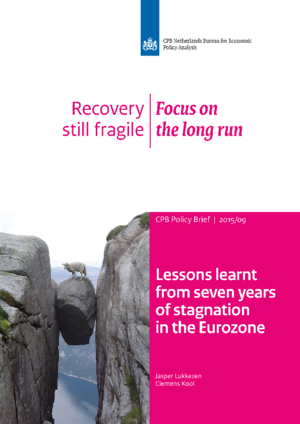Lessons learnt from seven years of stagnation in the Eurozone
Three lessons learnt from seven years of stagnation in the eurozone
The first one being that prevention is better than cure, which applies particularly to problems of excessive debt. Second, individual economies within the eurozone should be sufficiently robust to withstand shocks. This means having a flexible economic structure and public finances with a healthy foundation. Third, there should be a good balance between national and supranational policy frameworks. Over the last years, the European frameworks for banking supervision and budgetary and monetary policies already have been modified, substantially, but if this will prove to be sufficient to prevent recession under new large shocks on the financial markets warrants further investigation. These are the conclusions by CPB Deputy Director Clemens Kool and CPB researcher Jasper Lukkezen in the CPB Policy Brief ‘Lessons learnt from seven years of stagnation in the eurozone’, published today.
According to the researchers, it is still too early to conclude that this period of very low growth has definitely passed. For the short term, the vulnerability of the current recovery must be taken into account. For the long term, it would be wise to implement structural reform on labour and product markets. At the same time, the financial scope available within the Stability and Growth Pact (SGP) could be utilised to absorb the negative impact of these reform measures in the short term. In addition, it would be good for the balance sheet problems of households and non-financial companies if they could be solved more quickly and efficiently.
Public investments with a positive net constant value, such as in infrastructure, could also be moved up, both in individual Member States and on European level. To this end, a plan already has been developed by Chairman Juncker of the European Commission (Juncker Plan). CPB researchers think it is still too early to assess the effects of the quantitative easing by the European Central Bank.
The long period of low growth has led to permanently lower income levels, as investment levels also have been lower. Furthermore, the long-term unemployed have lost their professional skills. However, it seems less likely that growth levels have been affected for the long term, as growth factors such as demographics and technological development ultimately will dominate. Balance sheet problems slow down economic growth, but will probably even solve themselves without outside intervention, albeit at a slow pace and high costs.
Read the accompanying press release.
First, to prevent is better than to cure, and this applies particularly in the case of excessive debt problems. Second, the individual economies within the eurozone should be sufficiently robust to withstand shocks. This means having a flexible economic structure and public finances with a healthy foundation. Third, more attention must be paid to the balance between national and supranational policy frameworks. As a result of the financial crisis, the European frameworks for banking supervision and budgetary and monetary policies already have been modified, substantially. Whether this will prove to be sufficient to accommodate new large shocks without leading to another great recession warrants further investigation.
The eurozone economy today is as large as it was at the beginning of the financial crisis, seven years ago. This long period of low growth will likely lead to permanently lower income levels, because investments are lower and the long-term unemployed are losing their working skills. However, it seems less likely that growth will remain at this low level in the longer term. After all, over the long term, factors such as demographics and technological development will dominate. Balance sheet problems will probably solve themselves without outside intervention, albeit at a slow pace and at high costs.
It is, however, too early to conclude that this period of very low growth has definitely passed. To reduce this downward risk in the eurozone structural reforms should be implemented where necessary. To reduce the negative impact of reforms in the short run it can be sensible to utilize the space available within the Stability and Growth Pact (SGP). Likely candidates for reform are the labour and product market reforms and measures that help to address balance sheet problems. In the current situation, this also applies to moving up public investments that would have a positive net present value, both in individual Member States and on a European level. The Juncker Plan has been set up for this purpose. It is still too early to assess the effects of the quantitative easing by the European Central Bank.
